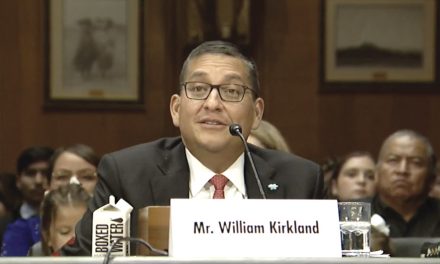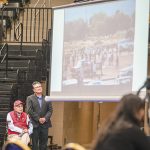
50 Years Ago: Chippewa chairman’s joke lands him in hot water
One of the changes in newspaper coverage in the Navajo Times instituted by Chet MacRorie after he took over the editorship of the paper in 1971 was to include coverage of what was going on in the national Indian scene.
He realized that there was a lot of interest within the paper’s readership in what was going on with the outside Indian community because it often had an effect on the Navajo Reservation.
MacRorie said he had wanted to do this during the other two times he was editor of the Times but there was no way to get reliable news about what was going on in the other tribes.
By 1970, that had changed as more tribal papers began reporting news instead of being just a bulletin board. At the same time, news services, like Native American News and later Indianz, started providing Native American publications a rundown of news that may be of interest to their readers.
The Times often included this news on its front page and MacRorie reported getting favorable responses from readers.
Fifty years ago, the paper told readers of an event that had occurred in Minneapolis a couple of weeks before. Robert Jourdain, chairman of the Red Lake Chippewa Tribe, was arrested for bringing a bomb onto an airplane. It turned out to be a mistake but it caused Jourdain to miss his flight.
It turned out that the flight crew mistook an Indian territorial map for a bomb.
When questioned by FBI agents, Jourdain said when a stewardess asked him what was in a tube he was carrying, he told her it was “wampum.” The stewardess, however, told FBI agents
that Jourdain said he was carrying a bomb.
Jourdain was on his way to Washington, D.C., with other delegates to attend the annual meeting of the National Congress of American Indians. When he was removed from the plane, the other delegates deplaned with him in protest.
A member of the delegation who was sitting next to Jourdain told FBI agents that he heard the exchange between Jourdain and the stewardess and he definitely head him say “wampum,” which is a belt made up of seashells or other objects to memorialize an important meeting.
After about an hour, FBI agents released Jourdain but this was not the end to his problem.
When his delegation got tickets to resume their trip, the airline refused to issue one to Jourdain, saying it was airline policy to prohibit anyone accused of carrying a bomb on their plane from traveling on any of their planes for 24 hours. Jourdain had to book another flight on a different airline.
BIA calls for airport
The Bureau of Indian Affairs issued a report saying that the reservation needs an airport that can handle jet planes and it needed to be built by 1980.
The tribe and the BIA were making the final plans to start developing a tribal farm on 110,000 acres of tribal land south of Farmington. Development of the farm was expected to begin in a couple of years and be completed by 1982, paving the way for the creation of dozens of Navajo-owned businesses, which would need an airport where jet planes could land to handle all of the business created by the farm.
The study done by the BIA was predicting a major boom in economic development once the farm was up and running. The farm would provide work for thousands of Navajos who would be needed to manage the farm and run businesses to process the crops grown there.
To make this possible, the BIA was planning to spend upwards of $60 million as the farm was completed to give Navajo businessmen the startup capital they needed to build and equip the plants.
They were looking at building the airport in Red Mesa or in the small Navajo community of Crouch Mesa.
Of course, like almost every economic development plan drawn up by the BIA, that never materialized in part because the federal government reneged on promises to develop 10,000 acres of land a year.
Today, some 40 years after the farm was to be completed, the tribe is still seeking federal funding to develop the final 20,000 acres.
Navajos eye Bottle Hollow
Back in 1886, the U.S. Cavalry built a fort in northeastern Utah to protect settlers from Navajos living in Utah as well as from the Utes and Comanches, who were more likely to be a problem to the settlers.
Named Fort Duchesne, the fort was closed down in 1912 with the soldiers seeing almost no action. But they did spend a lot of time drinking whiskey and then throwing their bottles in a gully near the fort. The name of the gully, for obvious reasons, was “Bottle Hollow.”
Now the headquarters of the Ute Tribe, plans were being made to spend more than $8 million to build a resort that would provide tourists opportunities to swim, hike and ride horses.
The Times strongly suggested Navajo officials watch to see how this goes — such a resort could be developed at Tsaile Lake or near LeChee.
Silversmiths, take note
The Times told Navajo silversmiths to take note of a recent press release put out by the U. S. Mint. It seems the agency was having a hard time finding someone who could help them design new plates for producing greenbacks.
After searching for several months with no luck, the agency was now trying to find a Navajo silversmith after hearing of their ability to come up with new and intricate designs.








 Highway 264,
Highway 264, I-40, WB @ Winslow
I-40, WB @ Winslow